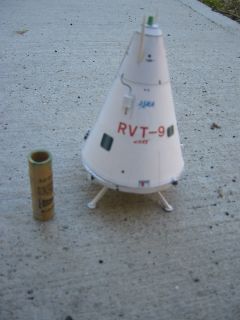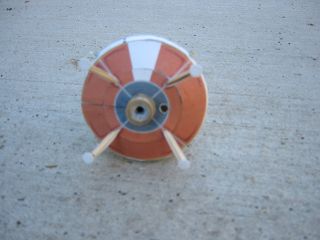Paper Resuable Rocket Vehicle (RVT-9) Plan
Paper - Resuable Rocket Vehicle (RVT-9) {Paper}
Contributed by Clive Davis
| Manufacturer: | Paper |
 Brief:
Brief:
The following website offers free plans of card models to construct: http://www.currell.net/models/index.htm
I thought it would be fun to build the Single Stage to Orbit Rocket RVT-9, a prototype Japanese rocket that has had limited success in field tests. I followed most of the instructions for the card model but ended up adding a 13 mm motor mount to the interior, drilling holes for the launch lug, and adding toothpicks to the card stock legs. My initial plan was to build the rocket for the Estes A10-P motors, as there would be no need for wadding or a need to protect the inside of the rocket. I also hoped that the rocket would be light enough to survive a tumble back to earth.
Modifications:
The rocket consists basically of constructing the main shroud, adding centering rings, adding the bottom nozzle unit with card stock legs, nose cone unit, and then external details such as little pitch and yaw nozzles, electrical boxes, antennae, etc.
I constructed the model as directed but at the bottom of the rocket, instead of completing the external engine nozzle, I cut a space into the heat shield to make space for the 13 mm tubing. I then inserted the tubing into the rocket, measured the length of BT-5 necessary for a small extension past the bottom of the rocket. I cut the selected amount and simply glued the BT-5 into the rocket. There is no need for centering rings if the BT-5 extends all the way to the nose. I also added the thrust ring to ensure that the motor extends .25" out from the end of the rocket.
 After completing the rocket, I used my Dremel to drill a hole in the bottom of the rocket near the motor mount. I used a launch rod to guide my eye to the place at the top of the rocket where the launch rod would extend, and drilled a hole at this point. I added a small length of launch lug at this point so that it would be easy to guide the rocket on the pad.
After completing the rocket, I used my Dremel to drill a hole in the bottom of the rocket near the motor mount. I used a launch rod to guide my eye to the place at the top of the rocket where the launch rod would extend, and drilled a hole at this point. I added a small length of launch lug at this point so that it would be easy to guide the rocket on the pad.
I then used the swing method (tricky with a cone shaped rocket) to determine if I had enough nose weight to establish a stable flight. I added weight up through the BT-5 past the thrust ring up in the nose cone portion of the rocket.
Construction:
I used a color ink jet printer to print the patterns on to 8.5" x 11" bristol board (card stock). The patterns fit on to 2 sheets. The rest of the instructions can be printed up on regular paper. Other items needed to convert the RVT-9 to a flyable rocket: 13 mm (BT-5) tubing, a thrust ring, wood glue, clay for nose weight, 1/8" launch lug, toothpicks for additional structural support.
The main PROs about this project are the cost and availability of parts. Anyone with a printer, a spare BT-5, and some card stock can build this rocket for the cost of a few cents. It is already decorated with colored letters, symbols and text. There is very little that needs to be done to convert it to a 13 mm motor mount rocket.
The main CONs about this project are that since the material is made of card stock, the rocket is somewhat fragile. The card stock legs were too flimsy, so I added some toothpick supports underneath them. Also, since I used an ink jet printer, I had to be careful that I did not put any moisture on the printed paper. The finished rocket should really be sprayed with some Krylon gloss overcoat or something similar. Also, some of the small external detail is so tiny and fragile, it is hard to glue on to the body. It is also difficult for the details to remain attached to the body without accidentally bumping them off.
Flight:
I prepped the rocket with an A10-PT. Because there is no ejection charge, no wadding is needed. It flew surprisingly well, rather straight at first with only a little wobble at the end of the ascent. If you make one of these rockets, just make sure the CG is in the upper half of the rocket so that it is stable. My overall weight came to 15 grams (about .5 oz). At apogee, the rocket flipped over and tumbled back to the ground. I did not lose any external detail, although one of the legs took a pounding and needs a little glue reinforcement.
PROs for flight: easy prep. It's the perfect rocket for those A10-PTs.
CONs: Although the rocket tumbled rather safely to the ground only damaging one of the legs, I don't think the rocket will survive many flights without some further modifications. Also, the small external details are fragile. I lost one little black pitch/yaw nozzle on the pad while hooking up the igniter clips. Strangely, I did not lose any when it bounced around on the ground on recovery.
Summary:
This is a great little rocket that was meant to be constructed for static display, but with a little invention can fly quite well. Looking back on my experimentation, I think it may be possible to make the nose cone separate from the rest of the rocket, using a small part of an expended engine as a coupler. With this adjustment, one could use Kevlar® for a shock cord and add a long streamer for recovery. This may slow the rocket down even more than the tumble recovery. This would also mean that one would have to use an A10-3T or maybe even an A3-2T motor for flights.
Other:
Great little rocket, fun to fly, fun to build, and requires little modification for flight. Just be forewarned that some of the parts are extremely tiny and will require a certain amount of patience.
Sponsored Ads
 |
 |











